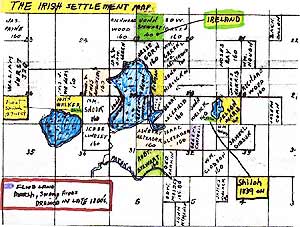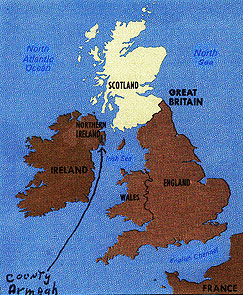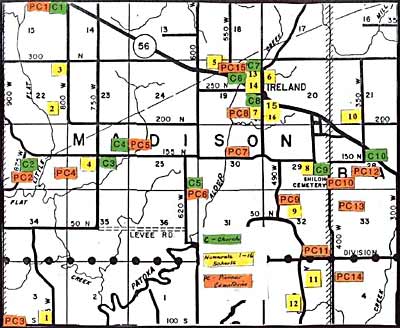"The Irish Settlement"
This was the name fondly given the area south by southwest of Ireland, Indiana.The forefathers of the early settlers of this settlement actually originated from Scotland. A logical point for beginning the migration is 1600. Some of the Irish Settlement's forefathers came to Ireland as servants. After being in Ireland for several years, they had gained more than enough money to make the trip to America. When they left Ireland, the crossing to America usually took 6 to 8 weeks, but with a promise of land and a new life in the new country the trip didn't seem that long.The Irish Settlement area was almost totally forest in 1814. These American pioneers had sold their land in the south and they liked what they saw in the soil and the forests of the settlement. They eventually purchased large tracts of land and cleared away some of the forests, and helped organize the county. These sturdy Scoth-Irish-American pioneers were venturesome, religious, usually industrious, determined and courageous. The pioneers of the Irish Settlement came into the area from Virginia, Pennsylvania and North Carolina. The first person to enter land in the settlement, on June 15, 1814, near the western edge in Section 26-Twp. 1 S- Range 6 W of Madison Township, Dubois County, was Jonathan Walker. This land was in four different counties, Knox, Gibson, Pike, and finally Dubois County. Walker was a veteran of the War of 1812. He was one of the prominent characters of the early days. He was a large, robust, pugilistic fellow who attracted attention in any crowd on account of his physical vigor. A book could be written about this man. For example, George R. Wilson, famous Dubois County Historian, relates that once during a term of court Walker, a hero of Tippecanoe, made a wager that he could crawl on his hands and knees in snow, mud and slush, from the court house south to Patoka River, swim the river, and then return to the courthouse, on his hands and knees. Walker won. Also noted by George R. Wilson, on page 81 of Wilson's History of Dubois County, Jonathan Walker, the well known fist fighter lived on the pigeon roost land reportedly in Cass Twp., Dubois County. Jonathan Walker is buried in the Mt. Vernon Cemetery near the Dubois-Spencer County line along US 231 in Cass Township. John Stewart, also a veteran of the War of 1812, entered 160 acres of land on December 23, 1816 that now includes the town of Ireland (Ireland, Indiana was an outgrowth of the Irish Settlement). Stewart served in Missouri in a Company once commanded by Danie Morganl Boone, Daniel Boone's son.. Robert Stewart, John's brother, was the first coroner of Dubois County. He was known far and wide as the pioneer gunsmith of the Irish Settlement. It is said Indians came to him , from time to time, to have silver put on the beads of their rifles. The silver was reported to have come from near the Patoka River in Madison Township. However, this report was never documented. Many of Benjamin Dillin"s family came into the settlement in 1815 and settleled in the Southeast portion of the Irish Settlement. Some of the family is buried in the Alexander Cemetery. There is also a Dillin Cholera Cemetery described in the cemetery portion of the website. Nelson Harris, another 1812 war veteran, entered the first land in Bainbridge Township in Section 28-Twp. 1-S-Range 5 W. This was the most easterly border of the Irish Settlement. It was said that Nelson Harris was never seen in public without a red flannel shirt on. He was recognized as the best deer hunter of his day. Elizabeth Cartmill Green, the wife of James Green a Revolutionary War soldier, came to the settlement in 1815. She came through the Cumberland Gap in Virginia and Kentucky. James had died in Kentucky leaving Elizabeth 13 children to raise. Almost every family in the Irish Settlement, during the early days, was related to that Green family. Elizabeth raised her family and lived in the settlement 24 years until one morning when she went out to gather eggs in her small hen house and was bitten by a rabid fox. This happened in 1839, Elizabeth died several hours later. It must be remembered that this portion of Dubois County was in 1812 a part of Knox County, in 1813 a part of Gibson County, then later a part of Pike County. In 1817 it became Dubois County. So it can be said that all the early Irish Settlement pioneers, including William Anderson, Sr., a Revolutionary War soldier and Thomas Anderson,Sr., father and son, lived in four Indiana counties and never left their homes. This did happen because the area was first in Knox then Gibson and then Pike and finally Dubois County. William joined the service when he was 17. Wilson's History of Dubois County states that Thomas was in the battle of New Orleans and saw Sir Edward Pakenham fall from his large white horse, on the battlefield of Chalmette. Many of the American pioneer settlers in Southern Indiana came from the overflow of the Scotch-Irish who had settled in Kentucky and Tennessee and who possessed the stern character of the Scotch with a foundation of the Calvinistic theology. The Irish Settlement folks came from that portion of the South where the Presbyterians have strong congregations. Church services were held in the Irish Settement before 1817. Old Shiloh, in the settlement, was a favorite meeting place. It was originally called "Alexander's Camping Ground." It is said that Shiloh was one of the first congregations of the Cumberland Presbyterian Church in Indiana. Shiloh, in its early day embraced all the land described on a map to be published later on this site. Shiloh was the center of the Irish Settlement. Mr. and Mrs. Ashbury Alexander lived southeast of Hillsboro Cemetery. They were among the founders of the Irish Settlement. Mrs. Alexander came from Kentucky. In 1815, she wrote to the Rev. David Lowry to come from Kentucky and conduct services at the double-log residence of William Anderson, Jr., and thus the Cumberland Presbyterian Church was brought into the Irish Settlement. At one time the Hillsboro Cemetery area was know as "Old Shiloh" and the first Shiloh Log Church was one quarter of a mile southwest of Hillsboro Cemetery. On October 2, 1827 the fourth meeting of the Presbytery in Indiana was held at Shiloh. Practically all the prominent men of the church attended. On September 25, 1834 the Presbytery was again held at Shiloh. Willis Niblack represented Shiloh. In April 1831, an effort was made to do away with camp meetings in the Presbyterian Church, but the local Indiana authorities favored them. The record reads: "Ordered, therefore, that they promote and endeavor to encourage our brethren to keep them up and pray for their prosperity. The English, Irish and Scotch who came early to America taught the world a lesson. The rigorous hardships of those who left the Old World to seek liberty and a freedom to worship God should ever be clearly before us. The so-called Irish of the Irish Settlement were Scotch-Irish with emphasis on the Scotch. The Scots are a stubborn race of people and an overwhelming majority of the Irish Settlement were by birth or ancestry of the Scotch type. The Irish Settlement was favorably known for miles as the most aristocratic settlement in Southern Indiana. Their ancestors came from the Blue Ridge and Smoky Mountains and from the states of Pennsylvania, Virginia, Carolina, Georgia, Kentucky and Tennessee. They carried with them the proud oriflamme of advancing civilization. These pioneers brought with them ideas of spiritual and intellectual freedom. They established churches and, in time, free schools. Their restless spirit was shown by their religious excitement and their frequent revivals and camp meetings. There was no greater outburst, or force than that of their religion. The first school administrator of Dubois County, John McCausland, was from the Irish Settlement. He served from 1843 to 1851. Reverend Andrew Jackson Strain, who at one time served 10 different churches, was the second county school administrator, beginning in 1851 and serving in that position until his death in 1873. These two gentlemen were the fathers of free schools in not only the Irish Settlement but in all of Dubois County. The first school administrators had many hardships in trying to establish the free schools. However, when it came to discipline, the parents knew it was their obilgation to raise their children in the proper manner. One of the truths of those days was "If you get a licking at school, you'll get a worse licking at home." No one considered this child abuse because it was meant to help guide the students--and it did get their attention! The Irish Settlement was never lacking in patriotism. It was originally settled by American pioneers who were not afraid to fight. Two Revolutionary, several War of 1812, Mexican War and Spanish-American War soldiers lived in the settlement. Also, later, on May 4, 1861 the Ireland Home Guards were organized to fight in the Civil War. Almost every able-bodied man in the Irish Settlement volunteered his services. Not nearly all the pioneer settlers in the Irish Settlement are mentioned. By not mentioning others, this writing does not take away from each one's importance to the Irish Settlement. Some of the above material was taken from a writing of Margaret A.Wilson in 1928. Some of the material came from Wilsons History of Dubois County, published by George R. Wilson in 1910. Ethel (Hopkins) Hardin, the writers grandmother and a native of the Hillsboro Community in the Irish Settlement, "handed-down" some of the above written material. Delbert "Junie" Himsel Irish Settlement Location Map of Schools, Churches, and Pioneer Cemeteries of the past & present.
|
|
Schools (yellow), 1. Green, 2. Beech Point, 3.Adams, 4. Hillsboro, 5. Mahan, 6. Stewart (log), 7. Corn (log), 8. Shiloh, 9. Alexander, 10. Hopkins, 11. Pirtle, 12. New Antioch, Schools 1-12 were one room schools 13. St. Mary's, 14. 1864 Ireland Grade & High School, and 15. 1915 Ireland Grade & High School. The area has only one school now, the 1990 Ireland Elementary School (K-5). Ireland High School consolidated with Jasper in 1970. Churches (green) 1.Bethel, 2. Anderson CP, 3.Hillsboro CP, 4. Old Shiloh CP (log), 5. Mt. Zion CP, 6.Ireland Methodist, 7. St. Mary's Catholic, 8. Ireland CP, 9. Shiloh CP, and 10. Shiloh United Methodist Church. CP stands for Cumberland Presbyterian, the first demonination in the settlement. The Old Shiloh Log was the oldest church. Number 9, Shiloh CP was built in 1849 and is in the National Register of Historical Places and is known as The Shiloh Meeting House. The Ireland Methodist Church is now the Ireland Historical Society. Number 7, St. Mary's Catholic Church and Number 10, Shiloh United Methodist Church are currently the only active churches. All other church buildings have been removed. However, Grace & Truth Baptist Church is presently renting the Ireland Historical Society building. (2019) Pioneer Cemeteries (PC) (orange), 1. Bethel, 2. Anderson, 3. Risley, 4. Jackson, 5. Hillsboro, 6. Mt. Zion, 7. Armstrong, 8. Corn, 9. Alexander, 10. Shiloh, 11. Dillin Cholera, 12. Nelson Harris, 13.* Wilhoit, . . 14..McMahan/Niblack, and 15. St. Mary's. Of these cemeteries, Shiloh, Mt. Zion and St. Mary's are the only active cemeteries. Number 13, Wilhoit, was destroyed by a developer. |
|
 |
 |
1. Irish Settlement Map in 1830 of the first landowners. Of these owners Jonathon Walker was the first, entering his land on June 15, 1814. This map was drawn by George R. Wilson. 2. Map showing location of County Armagh. where the Scoth/Irish settlers of the Irish Settlement went to when they left Scotland. Later they left from Ireland and came to the United States If anyone has any information on any of the pioneers mentioned in this segment of this website or if anyone from the countries of Ireland or Scotland has any comments or information of any kind that they wish to share, CLICK HERE to email Delbert Himsel, Jr. |
|
